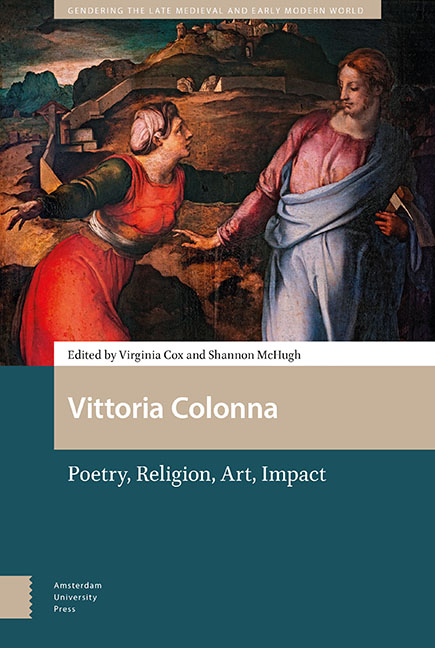Book contents
- Frontmatter
- Dedication
- Contents
- List of Illustrations
- Acknowledgements
- Introduction: The Twenty-First Century Vittoria Colonna
- Part 1 Literary and Spiritual Sociability
- Part 2 Widowhood
- Part 3 Poetry
- Part 4 Art
- Part 5 Readership
- Part 6 Impact
- Volume Bibliography
- Index of Citations of Colonna’s Letters and Verse
- Thematic Index
15 - ‘She Showed the World a Beacon of Female Worth’: Vittoria Colonna in Arcadia
Published online by Cambridge University Press: 16 December 2021
- Frontmatter
- Dedication
- Contents
- List of Illustrations
- Acknowledgements
- Introduction: The Twenty-First Century Vittoria Colonna
- Part 1 Literary and Spiritual Sociability
- Part 2 Widowhood
- Part 3 Poetry
- Part 4 Art
- Part 5 Readership
- Part 6 Impact
- Volume Bibliography
- Index of Citations of Colonna’s Letters and Verse
- Thematic Index
Summary
Abstract
The Accademia dell’Arcadia (founded 1690) deserves to play a leading role in any account of Vittoria Colonna's posthumous influence. The author of the first ‘critical’ edition of Colonna's verse, Ercole Visconti, was an Arcadian, as was Giovan Maria Crescimbeni, who presented Colonna's work in his Istoria della volgar poesia as an ‘inexhaustible mine of the finest gold’. The many female poets of the Academy also recognised and paid tribute to Colonna's inspiration. This chapter investigates Colonna's role as literary model within the Academy, covering all the key phases, from the early eighteenth to the nineteenth century, and examining the ways in which gender inflected the practices and stylistic ideals of this powerful cultural institution.
Keywords: Accademia dell’Arcadia, Giovanni Mario Crescimbeni, literary academies, female poets, canon formation
It was her grief at that eternal and fateful separation from her Marquis Fernando of Pescara that dictated those queenly sonnets to the woman Michelangelo adored … We women are considered plagiarists, or, at best imitators, when we write epics, dramas, histories, scientific treatises, but the woman who sings of her love copies no one; she coins her ideas fresh from the mint and seals them with her own wax and imprint.
On the pseudo-poetry of Arcadia and its (partial) right to existence
Like ‘sparkling, many-coloured glass baubles’ that attract ‘barbarians’ accustomed to ‘piling themselves high with ornaments’—in just such terms does Benedetto Croce definitively characterize the Baroque poetic excesses of the irrational Italy of the Counter-Reformation. These trinkets shimmer away, illusory and bereft of any true value, representing the final stage of a trajectory that has ‘in one continuous line gone from troubadour lyric and Petrarchism to the showy poetry of Marino and the Baroque’. Within this critical perspective, it is precisely by virtue of its strenuous resistance to the dazzling, empty glitter of seventeenth-century literature that the eighteenth-century Accademia dell’Arcadia deserves such prominence. It has the merit of promoting an ‘ordered’ and ‘limpid’ model of literature, inspired by the principles of Cartesian rationality that had already taken root in the rest of Europe. Although Croce had little time for the aesthetic ideals of either the supporters of Arcadia or its detractors, he nonetheless helped to ensure that eighteenth-century Arcadian literature and Baroque literature would be seen as antithetical: a position that continues to condition our vision of both movements right down to the present day.
- Type
- Chapter
- Information
- Vittoria ColonnaPoetry, Religion, Art, Impact, pp. 351 - 370Publisher: Amsterdam University PressPrint publication year: 2021
- 1
- Cited by

